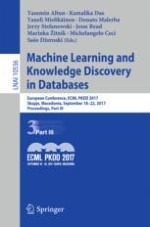The three volume proceedings LNAI 10534 – 10536 constitutes the refereed proceedings of the European Conference on Machine Learning and Knowledge Discovery in Databases, ECML PKDD 2017, held in Skopje, Macedonia, in September 2017.
The total of 104 papers presented in these books was carefully reviewed and selected from 364 submissions. The papers were organized in topical sections named as follows:
Part I: anomaly detection; computer vision; ensembles and meta learning; feature selection and extraction; kernel methods; learning and optimization, matrix and tensor factorization; networks and graphs; neural networks and deep learning.
Part II: pattern and sequence mining; privacy and security; probabilistic models and methods; recommendation; regression; reinforcement learning; subgroup discovery; time series and streams; transfer and multi-task learning; unsupervised and semisupervised learning.
Part III: applied data science track; nectar track; and demo track.
